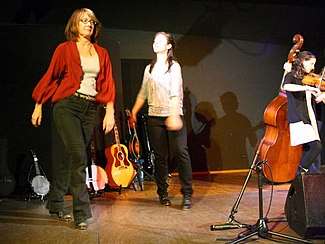Clogging
Clogging is a type of folk dance practised in the United States, in which the dancer's footwear is used percussively by striking the heel, the toe, or both against a floor or each other to create audible rhythms, usually to the downbeat with the heel keeping the rhythm.

Description
The dance style has recently fused with others including African-American rhythms,[1] and the Peruvian dance "zapateo" (which may in itself be derived from early European clog dances), resulting in the birth of newer street dances, such as tap, locking, hakken, stomping, and Gangsta Walking. The use of wooden-soled clogs[2] is rarer in the more modern dances since clog shoes are not commonly worn in urban society, and other types of footwear have replaced them in their evolved dance forms. Clogging is often considered the first form of street dance because it evolved in urban environments during the industrial revolution.
In later periods it was not always called "clogging", being known variously as foot-stomping, buck dancing, clog dancing, jigging, or other local terms. What all these had in common was emphasizing the downbeat of the music by enthusiastic footwork. As for the shoes, many old clogging shoes had no taps and some were made of leather and velvet, while the soles of the shoes were either wooden or hard leather.
Clogging can be divided into five major categories: 1) shuffle clogging, 2) cadence clogging, 3) rhythm clogging, 4) stomp clogging, and 5) buck-dancing.
The shuffle clogging style is said to be the most popular style for bluegrass music cloggers while rhythm and stomp clogging are more popular with old-time music cloggers. What sets clogging apart from other dance styles such as tap-dancing is the lack of upper body movement used during performance like Irish Sean-nós dance which had significant influence on the origins of the dance. While tap dancers place emphasis on stage presence and arm movements, cloggers limit their upper body movement, focusing primarily on their feet.
Antecedents
In the United States, team clogging originated from square dance teams in Asheville, North Carolina's Mountain Dance and Folk Festival (1928), organized by Bascom Lamar Lunsford in the Appalachian region.[3]
American Clogging is associated with the predecessor to bluegrass—"old-time" music, which is based on English, and Irish fiddle tunes as well as African banjo tunes. Clogging primarily developed from Irish step dancing called Sean-nós dance[4]; there was also some English, Scottish, German, and Cherokee step dances, as well as African rhythms and movement influences too. It was from clogging that tap dance eventually evolved. Now, many clogging teams compete against other teams for prizes such as money and trophies.
Terminology
The term "buck," as in buck dancing, is traceable to the West Indies and is derived from a Tupi Indian word denoting a frame for drying and smoking meat; the original 'po bockarau' or buccaneers were sailors who smoked meat and fish after the manner of the Indians.[5] Another source states that the word "bockorau" can be traced to the "Angolan" word "buckra', and was used to refer to white people,[6] which is disputed.[7] Eventually the term came to describe Irish immigrant sailors whose jig dance was known as 'the buck.'" Another origin of the term "buck dance" comes from the idea that this style of dance was a flirtation. The male dancer would show off his skills on the dance floor to attract the female, thus being compared to the buck's courting ritual of the doe.
One source states that buck dancing was the earliest combination of the basic shuffle and tap steps performed to syncopated rhythms in which accents are placed not on the straight beat, as with the jigs, clogs, and other dances of European origin, but on the downbeat or offbeat, a style derived primarily from the rhythms of African tribal music.[8]
Buck dancing was popularised in America by minstrel performers in the late 19th century. Many folk festivals and fairs utilise dancing clubs or teams to perform both Buck and regular clogging for entertainment.
Traditional Appalachian clogging is characterised by loose, often bent knees and a "drag-slide" motion of the foot across the floor, and is usually performed to old-time music.
See also
- American traditional informal freeform solo folk dancing
- Buckdancer's Choice
- Clog dancing
- Ira Bernstein
- Limberjack
- Sean-nós dance including as practised in America
- Step dance
References
Notes
- Clogging 2009.
- Cahill 2008.
- Thompson, Jessica Lee (2006). "State Dance: Clogging and Shagging". Encyclopedia of North Carolina. Retrieved 29 January 2018.
- http://www.doubletoe.com/history.htm
- Adelaide Bluegrass Cloggers 2010.
- Hashaw 2007, p. 42.
- Chuku 2012.
- Ames & Siegelman 1977, p. 41.
Bibliography
- Ames, Jerry; Siegelman, Jim (1977), The Book of Tap, David McKay Company, ISBN 0-679-50615-2
- History of clogging, Adelaide Bluegrass Cloggers, archived from the original on 15 October 2009, retrieved 24 April 2010
- Cahill, Mike (14 June 2008), Clogs, archived from the original on 5 March 2016, retrieved 20 February 2016
- Chambers, Douglas B (1 March 2005), Murder at Montpelier: Igbo Africans in Virginia, University Press of Mississippi, ISBN 978-1578067060
- Chuku, Gloria (17 August 2012), "Enslaved Igbo and the Foundation of Afro-Virginia Slave Culture and Society", ChickenBones, Nathaniel Turner, retrieved 20 February 2016 Review and criticism of Chambers (2005)
- "Clogging: How it's different from tap", Dance Spirit, Dance Media, 24 June 2009, retrieved 20 February 2016
- Hashaw, Tim (2007), Children of Perdition: Melungeons and the struggle of mixed America, Mercer University Press, ISBN 0-88146-013-3, retrieved 20 February 2016
- Spalding, Susan Eike; Woodside, Jane Harris, eds. (1995), Communities in Motion: dance, community, and tradition in America's Southeast and beyond, Westport, Connecticut, US: Greenwood Press
- Frank X. Bonner (1983) Clogging and the Southern Appalachian Square Dance, Creative Imprints of Marietta, Georgia, US
%2C_by_William_H._Johnson.jpg)
